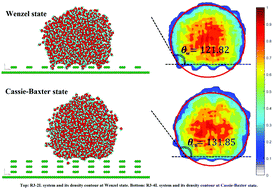Molecular investigation of the wettability of rough surfaces using molecular dynamics simulation†
Abstract
In the present study, a computational investigation on the effect of surface roughness on the wettability behavior of water nanodroplets has been performed via molecular dynamics simulation. To fabricate the roughness, several grooves with different depths and widths were considered on the top layer(s) of graphite. Free energy analysis indicates that surface roughness reduces the solid–liquid adhesion and the work done for the removal of the nanodroplet from the solid surface. This reduction increases with an increase in both the depth and width of the grooves. Furthermore, the adhesion in Wenzel state is greater than that in the Cassie–Baxter state. Results show that increasing the depth and decreasing the width of the grooves decrease the wettability and the nanodroplet locates in the Cassie–Baxter state. In addition, both the Cassie–Baxter and Wenzel models effectively predict the nanodroplet contact angle on the rough surfaces. Furthermore, the probability of successful interactions decreases in the solid–liquid interfaces due to the heterogeneity of the surface. Therefore, the density, the residence time and the hydrogen bond lifetime of the water molecules in the layer in the vicinity of the substrate decrease. In addition, surface roughness affects the orientation of the water molecules at the interface, the diffusion of water molecules as well as the movement of the water nanodroplet.



 Please wait while we load your content...
Please wait while we load your content...